How To Line Sewer Laterals
Posted by William Heinselman on
 OK, let's clear up the confusing terminology before we get ahead of ourselves here. When we say "sewer lateral" all we mean is the underground pipe that connects a a building to the sewer line. Simple enough, right?
OK, let's clear up the confusing terminology before we get ahead of ourselves here. When we say "sewer lateral" all we mean is the underground pipe that connects a a building to the sewer line. Simple enough, right?
The pipe is generally constructed of iron, and its considered the property of the building owner (as opposed to government property, like the actual sewer, itself). That's why this pertains to you. More often than not, if you ever had a problem with your sewer laterals, it would definitely be in your best interest to contact your local plumbing professionals.
How Lining Sewer Laterals Works:
- Taking A Look Down There
When it's first noticed that the sewer lateral might be broken, a camera is inserted into the pipe to discover the extent of the damage, in order to be sure sewer lateral lining is the best method to employ. If the pipe is cracked in anyway, the broken pipe will be "lined" with a new one - hence lining sewer laterals.
- Filling The Liner With Resin
Many companies then pour liquid resins into a pvc-coated liner. After that liner is laid flat on the ground and rollers are rolled over the liner to ensure that the resin fully coats the liner.
- Inserting The Liner
The liner is then inserted into the damaged pipe using a special device. When the liner is shot through the pipe with air pressure, it unfolds inside out so that the resin-soaked liner secures itself to the wall of the pipe.
- Inserting The Bladder
A bladder is then sent through the pipe, and is inflated with air pressure. This is to make the wet lining the wet lining further adhere to the inside of the pipe.
- Letting The Resin Cure
After a few hours pass, the resin cures, the bladder is taken out of the pipe, and what's left is a seamless new pipe wall.
- Double-Checking The Work
Just to make sure that the job is done correctly, the camera is sent through the pipe a second time.
Some Benefits Of The Procedure
The main benefit of lining sewer laterals is that it fills in missing sections in the pipe, but there are many other pros besides that. It stops infiltration and ex-filtration; it eliminates intrusion of roots into the pipe; the procedure works on practically any initial piping material - cast, clay, etc; and there's no host pipe needed to complete the process.
Do Not Try This On Your Own
All in all, if you're were thinking about maybe taking care of the procedure on your own, best of luck. This is definitely a home improvement project we do not suggest taking up DIY-style. Beyond not having the in-depth know-how to perform the procedure correctly, we're not sure where you'd find the equipment. So, it seems like it would turn out to be quite a hassle doing this on your own, instead of simply calling your local plumbing contractors.
You may think that you could take care of the problem, with a conventional pipe repair method - digging a trench, but it's very likely that you won't locate the exact point where the pipe needs repair. And, even if you do, you'll have made a mess of your yard, and put yourself in the face of some health risks.
If you suspect that that your sewer lateral is in need of repair, all you have to do is contact a local plumbing company. This why you won't be throwing your money directly down the drain.
Topics: Trenchless Technology, Sewers

![Repiping Your Sacramento Home [6 Steps]](https://www.expresssewer.com/hs-fs/hubfs/plumbing%20tools%20and%20blueprints.jpeg?width=550)




